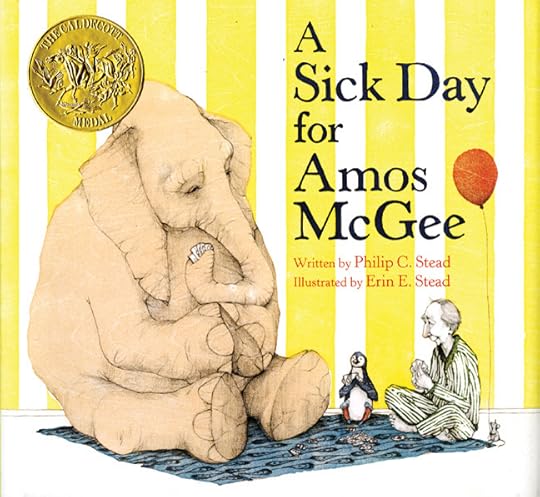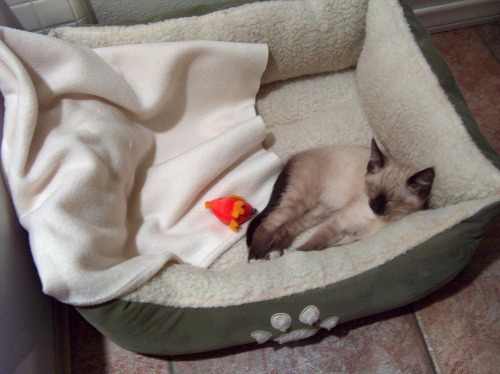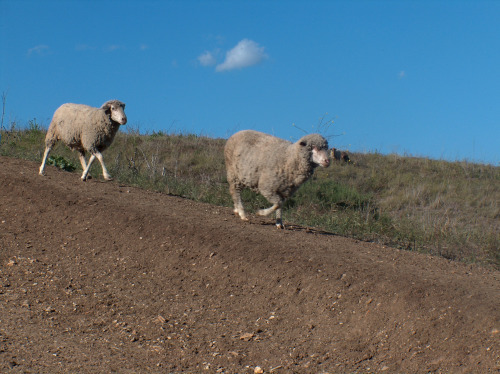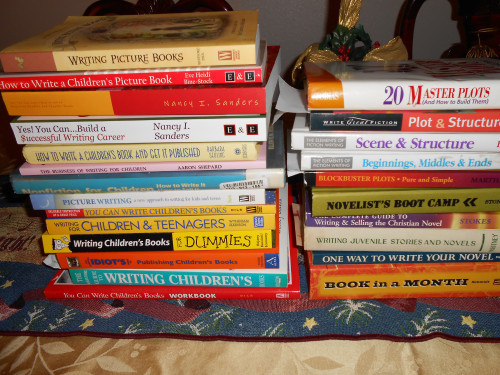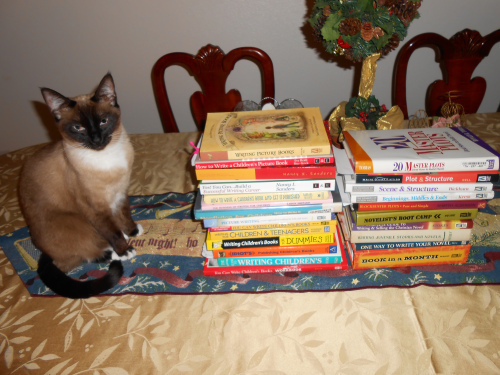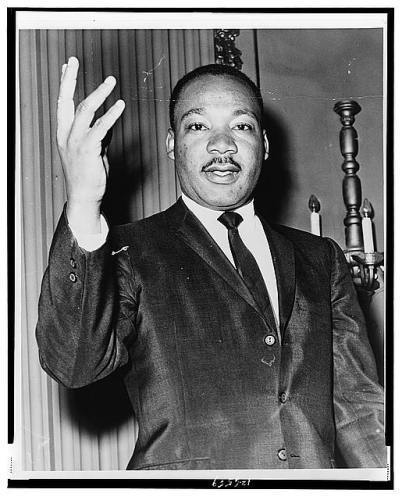Nancy I. Sanders's Blog, page 77
February 18, 2013
The Second Change
Every story has a middle. If you are writing a story that is structured using a story arc, the middle is where the main part of the action happens. The middle is where your main character deals with the main story problem. In the very heart of the middle you arrive at the exact center of your story. This center point divides the first half of the middle from the second half of the middle. It also divides the entire story in half. Once again, by learning how to create a significant change at this center point, you can write a story that keeps the plot moving forward while engaging your readers in a powerful way.
At the center of the middle, the second change occurs that holds significance in your story’s plot. Using A Sick Day for Amos McGee as our example again, we see that in the center of the book, on page 13, there is a significant change. Amos McGee wakes up sick and decides to stay home from work.
This change effectively divides the first half of the middle from the second half of the middle. It also effectively divides the entire story in half. In the first half of the middle, we see Amos McGee at work at the zoo, giving special individualized attention to his friends, the animals at the zoo. Yes, there are many different scenes here. But each scene has a similar theme in that it shows Amos being kind and caring to each of the different animals. An important change occurs after these scenes, and it’s this change that is the second change in the plot.
This second change introduces the second half of the middle. In our example, A Sick Day for Amos McGee, the second half of the middle is all about how the zoo animals miss their friend so much (because he stayed home from work) that they all decide to leave the zoo and go visit him!


February 16, 2013
Identifying the First Change
Let’s look at an example, the picture book, A Sick Day for Amos McGee, by Philip C. Stead and illustrated by Erin E. Stead. It’s the winner of the 2011 Caldecott Medal, the highest honor awarded to a picture book each year. I always like to look at award winners to see how they handle plot.
The book introduces the main character’s problem in the title itself. Picture books often do this. The beginning of the book starts with an introduction to the main character, himself. Amos McGee. We see Amos swinging his legs out of bed, putting on his uniform, and getting ready for work.
On page 7 of the picture book, Amos arrives at work. The illustration shows him walking through the entry gates of the City Zoo.
This is the first significant change in the plot.
Yes, there were various scenes leading up to this point. But all those scenes showed the same thing: Amos getting ready for work. There was a scene where he made his breakfast. There was a scene where he walked out the door. There was a scene where he rode the city bus and arrived at work exactly on time.
But on page 7, something changed. Amos was no longer getting ready for work. He arrived at work. This was the first big change in the plot of the story.


February 14, 2013
The First Change
Every story starts with a beginning. If you are writing a story that is structured using a story arc, the beginning is where you introduce your main character and the main character’s problem. The next part of the story is the middle. By learning how to transition from the beginning to the middle effectively, you can write a story that will keep your reader turning the page to find out how your main character handles his problem. Whether your reader is a three-year-old hugging her favorite teddy bear or an editor rushing through her pile of submissions looking for the next great manuscript, crafting a significant change at this point of the story arc increases the emotional attachment she’ll have in your story.


February 6, 2013
Basic Story Arc
The basic story arc is built upon a basic plot. It has a beginning, a middle, and an ending. It also had one very important ingredient added! It has a character with a problem.
You may have an idea for a children’s story or are already writing a children’s manuscript. Let’s say the idea is about an adorable kitten. You write about how the kitten is playful and sweet. You write about how the kitten wakes up, plays with a ball of yarn, chases its tail, and then curls up for a morning nap in the sunshine. There! You’re pleased with your story. In fact, the writing is very, very good! You’ve edited and polished it until it shines. Your story is finished and you submit it to a publisher with hopes of young readers (and editors) falling in love with your kitten as much as you have!
Unfortunately, most magazines or book publishers won’t offer you a contract for your story. Why? Because it doesn’t have a story arc. Yes, it has a beginning. The kitten woke up. Yes, it has a middle. The kitten played with a ball of yarn and chased its tail. Yes, it has an ending. The kitten curled up for a morning nap in the sunshine.
The key ingredient that is missing, however, is that your main character doesn’t have a problem. Without a problem, your manuscript is just about a series of events. Without a problem, your manuscript has no story arc.
A basic story arc starts with a problem. What kind of a problem, you may ask? Think Three Little Kittens Lost Their Mittens. The main character, or in this case three main characters, has a problem that is established in the beginning of the story. The three little kittens are in trouble with Mama because they have lost their mittens. This is the starting point of the basic story arc.
In the middle of the story, the main character makes attempts to solve the problem. The action rises in the story and the tension builds as we read about the main character’s efforts to reach her goal. Sometimes the efforts are successful. The three little kittens found their mittens. Sometimes the efforts create an even bigger problem. After the three little kittens found their mittens, they ate pie and got them dirty. They got in even worse trouble with Mama. This is the middle of the basic story arc.
At the end of your story, your main character solves the problem. The three little kittens washed their mittens. Now they’re not in trouble any more. In fact, now they are all set to chase the mouse that scampers near by! This is the end of the story arc. This is the end of your story.
In the beginning of the story, a basic story arc establishes the main character’s problem. In the middle of the story, a basic story arc shows the action building and the tension rising as the main character tries to solve the problem. In the ending of the story, a basic story arc shows the main character solving the problem.


February 4, 2013
The Basic Plot
One of the first things it’s important to know about plotting is that every story needs a beginning, a middle, and an ending. Yes, this may seem very rudimentary, but it’s surprising the number of times writers start a story with an exciting idea, but never know how to move it effectively into the middle. Another trap writers often face is to get lost in the muddle of the middle and now know how to bring a story to an effective end.
A beginning. A middle. An ending. That’s the basic on plot. Pure and simple.
Just identifying these three key elements of your children’s story will help your manuscript automatically get off to a great start.
Three questions to help you identify the basics of your plot include:
1. How does the story start?
2. What happens in the middle?
3. How does the story end?
Strengthen Your Writing Muscles
If you’d like a simple writing exercise, look above at the picture of the sheep. If you were going to tell a story about them to a child, how would your story start? (Where are the sheep coming from?) What would happen in the middle? (Where are these sheep going?) How would your story end? (What will happen when they get there?) Write down your ideas.


January 31, 2013
Books on Plot
Don’t you just love this hilarious picture of a dog sitting in the driver’s seat? I saw this big guy sitting in the parking lot and just had to snap his photo. Kind of reminds me of how I feel sometimes when I’m working on plot. I’m sitting in the driver’s seat of my manuscript but I’m just not too sure how to get my story where I want it to go.
That’s why I’m studying plot right now.
And here is a list of books that I currently own that focus on PLOT.
Advanced Plotting by Cris Eboch (Nook book)
Beginnings, Middles and Ends by Nancy Kress
Blockbuster Plots: Pure and Simple by Martha Alderson
Holly Lisle’s Create a Plot Clinic by Holly Lisle (Nook book)
Holly Lisle’s Professional Plot Outline Mini-Course by Holly Lisle (Nook book)
Plot and Structure by James Scott Bell
Scene and structure by Jack M. Bickham
The Plot Whisperer Workbook: Step-by-Step Exercises to Help You Create Compelling Stories by Martha Alderson
20 Master Plots (And How to Build Them) by Ronald B. Tobias
And even though these books don’t focus on plot, these are 2 of my current favorite books on writing novels that have good advice on plot:
Book in a Month: The Fool-Proof System for Writing a Novel in 30 Days by Victoria Lynn Schmidt
Novelist’s Boot Camp: 101 Ways to Take Your Book from Boring to Bestseller by Todd A. Stone
And actually, this list showcases the books that I’m reading right now as I try to digest a sweeping overview about plot. There’s so much here to dig into, though, that I know I’m going to go back and really focus on many of these steps and strategies to implement them into my own writing projects.
Yes, I’m reading multiple books at the same time, going back and forth between them, looking up topics in their index or table of contents and comparing their approaches. And trying to apply various techniques to various manuscripts that I’m racing to work on for different deadlines I have.
Wanna share any books that focus on plot that you love or even titles about plotting that you have on your bookshelf? There are so many books out there that it helps to get a personal recommendation.


January 28, 2013
More Books on Writing for Children
As I’ve been digging around on the Internet, here are a few more how-to-write books for children’s authors that look like they address plot in some shape or form. (And they just look like such great books to read!)
Second Sight: An Editor’s Talks on Writing, Revising, and Publishing Books for Children and Young Adults by Cheryl B. Klein
Story Sparkers: A Creativity Guide for Children’s Writers by Marcia Thornton Jones
The Writer’s Guide to Crafting Books for Children by Nancy Lamb
Writing it Right! How Successful Children’s Authors Revise and Sell Their Stories by Sandy Asher
Writing Magic: Creating Stories that Fly by Gail Carson Levine


January 25, 2013
Books on Writing for Children
As you can see in this picture, I’ve got a lot of books that I’m looking through right now on my journey to learn more about plot, especially for children’s manuscripts. (And I’ve even purchased about 10 more books on plot since I snapped this photograph, including half a dozen I bought for my Nook.)
Some of these books I’m devouring from cover to cover in a sort of speed-reading kind of way. This is to give me a fresh perspective on what resources are out there on plot and also to learn different authors’ basic philosophies/methods/strategies at a quick glance so I know what techniques are being taught in the industry today.
Other books only have a chapter or section on plot, but these sections are geared specifically to children’s stories and children’s writers. Here’s a list of the how-to-write children’s books I own that address plot in some way:
Creating Characters Kids Will Love
by Elaine Marie Alphin
How to Write a Children’s Book and Get It Published
by Barbara Seuling
How to Write a Novel for Young Readers and Get It Published
by Kathryn Falk and Cindy Savage
Nonfiction for Children: How to Write It, How to Sell It
by Ellen E.M. Roberts
The Way to Write for Children
by Joan Aiken
Picture Writing: A New Approach to Writing for Kids and Teens
by Anastasia Suen
The Business of Writing for Children
by Aaron Shepard
The Complete Idiot’s Guide to Publishing Children’s Books
by Harold D. Underdown
The Everything Guide to Writing Children’s Books
by Lesley Bolton
Writing Children’s Books for Dummies
by Lisa Rojany Buccieri and Peter Economy
Writing for Children and Teenagers
by Lee Wyndham
Writing Irresistible Kidlit: The Ultimate Guide to Crafting Fiction for Young Adult and Middle Grade Readers
by Mary Kole
Writing Juvenile Stories and Novels
by Phyllis A. Whitney
Writing Short Stories for Young People
by George Edward Stanley
Yes! You Can Learn How to Write Children’s Books, Get Them Published, and Build a Successful Writing Career
by Nancy I. Sanders (me!)
Yes! You Can Learn How to Write Beginning Readers and Chapter Books
by Nancy I. Sanders (me!)
You Can Write Children’s Books
by Tracey E. Dils
You Can Write Children’s Books Workbook
by Tracey E. Dils
Do you know of any other how-to-write children’s books I haven’t listed here that have a section or chapter on plot? Or are exclusively about plot? Please share so we can look at those, too!


January 22, 2013
Books on Plot
As you can see, my writing buddy, Pitterpat, has been helping me with plots. Or should I say helping me organize my books on plot?!
As I mentioned in a previous post, I have a bunch of books with information about plots. These books are divided into 4 main categories:
How to write picture books
How to write for children
How to write a novel
Plots
I wanted to let you know the titles of the books I’m exploring right now to help me learn more about plots.
In this post I’ll list the 2 books I have for “How to Write Picture Books.”
How to Write a Children’s Picture Book, Volume I: Structure
by Eve Heidi Bine-Stock
This is a must-have for any children’s writer who wants to write picture books. It discusses and teaches all about how to structure your picture book, which is essential when plotting your story.
Writing Picture Books
by Ann whitford Paul
Another must-have book for picture book writers. While covering a lot of ground about writing picture books, this book also includes a helpful chapter on plotting your picture book.
I have read both these books, refer to them often, and continue to learn a lot from them. I am referring back to them as I’m learning more about plotting a children’s story from beginning to end.
Do you know of any other how-to-write books that deal exclusively with picture books? If so, let us know the titles!!!!
In my next post I’ll list the titles of books I have on writing for children in general that contain information about plotting techniques.


January 21, 2013
Martin Luther King Day
Martin Luther King Had a Dream
Martin Luther King was a man for justice
Martin Luther King was a man for peace
Martin Luther King was a man for freedom
Martin Luther King had a dream
Martin Luther King wanted every person
Treated with respect and dignity
Martin Luther King took a stand for liberty
Martin Luther King had a dream
Martin Luther King lived a life committed
Helping all the people on the earth
Working for the world and looking to the future
Martin Luther King had a dream
Martin Luther King has left a vision
Every one of us can carry on
That we live in peace and love each other
Martin Luther King had a dream
Poem by Jeff Sanders
Photograph courtesy of the Library of Congress, LC-USZ62-126559


Nancy I. Sanders's Blog
- Nancy I. Sanders's profile
- 76 followers


